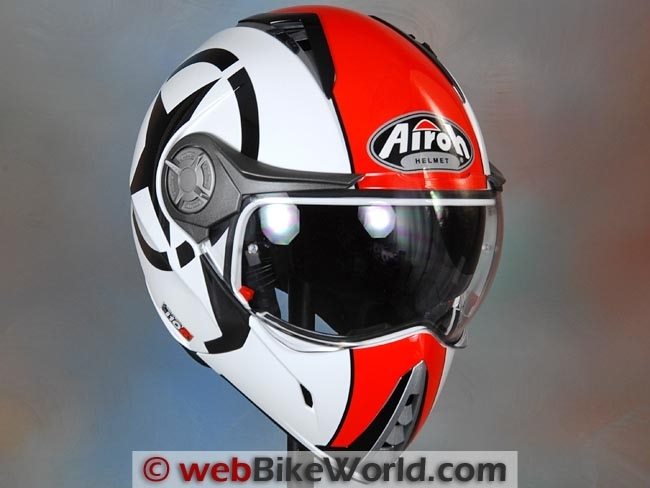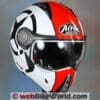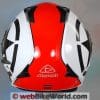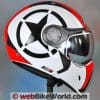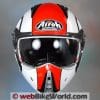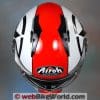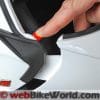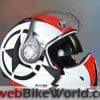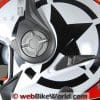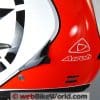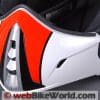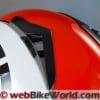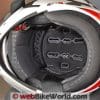Airoh J106 Helmet Review
The Airoh J106 is a true modular motorcycle helmet that can be converted from full-face to open-face in an instant.
It is dual homologated, meeting the ECE 22.05 P and J safety standards to be worn in either configuration whilst riding a motorcycle.
The J106 is very light, with a thin thermoplastic shell that feels quite different from other motorcycle helmets.
It’s finished to a good standard but it’s a bit quirky and the internal shape, fit and sizing is unique.
Airoh motorcycle helmets are different, there’s no doubt about that.
The company — and the helmets — are the passion of Antonio Locatelli, who started the firm and is the driving force behind the brand.
You won’t find those bland committee-based decisions being made at Airoh.
Instead, it’s all about the art and that passion, along with a dash of science.
The result is a company that is not your average motorcycle helmet manufacturer.
If this all sounds familiar, it should be…to webBikeWorld regulars anyway.
It’s very much like Roof Helmets in France. Airoh is the Italian equivalent of Roof, in my opinion — quirky genius that follows its own and decidedly different path.
You’ll either love ’em or hate ’em; there’s not much in between.
This is a very good thing actually, because too much decision by anonymous committee will yield bland “devices” rather than beautiful art.
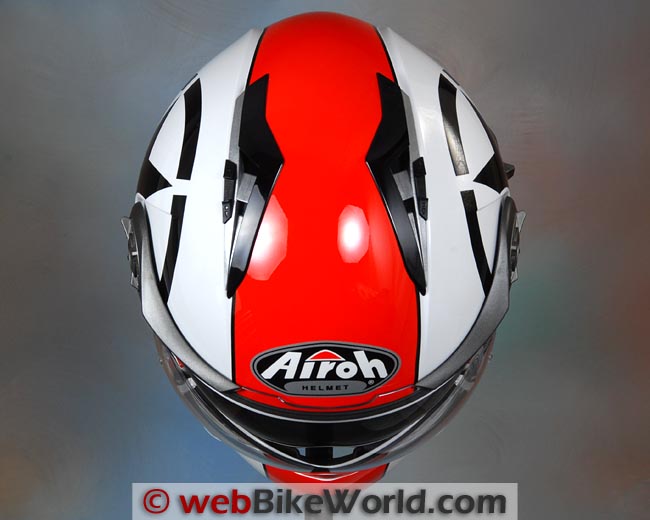
Introduction
Two Airoh helmets have previously been reviewed on webBikeWorld.com: the Airoh S4 (review)and the Airoh TR-1 (review).
The TR-1 is the direct ancestor of the Airoh J106 that is the subject of this review.
In fact, the J106 is very similar to the TR-1 in many ways; it employs the unique thermoplastic shell and it looks similar, but as the “Grandson”, it now includes a few modern updates.
Airoh helmets are not easy to find — in the U.S.A. or elsewhere.
But our friends at Burn Out Italy (Italy), who also own and manage the Boxer Helmets website (see our Roof Boxer V8 review), came through with a Airoh J106 and the Airoh Aviator off-road helmet, which will be reviewed next.
Burn Out Italy ships Caberg, Roof, Airoh and other helmets and products to happy and satisfied motorcycle riders in many countries all over the world.
The Airoh J106 a direct descendant of the Airoh TR-1 we reviewed back in 2007. The TR-2 came next, and now the J106. Why it wasn’t called the “TR-3” is anyone’s guess, but J106 it is.
Before I start, I have to say that reviewing an Airoh helmet is rather like reviewing a helmet from Roof, the French manufacturer.
What do I mean by that? Just that all preconceived notions about motorcycle helmet design must be set aside — the companies and many of their helmets are that different.
The J106 is very much like the TR-1 — and the Roof Boxer — in one regard: you’ll probably either love it or hate it.
The helmet will either fit or it won’t. You’ll either think the implementation of its features are ingenious or diabolical.
So keep that in mind as I guide you through the review. I can tell you this:
The webBikeWorld Airoh TR-1 review still gets plenty of visitors and comments, and webBikeWorld readers have been requesting more Airoh reviews ever since. So the company must be doing something right.
By the way, in addition to the J106, Airoh makes a huge line of helmets of all types: full face, modular, open-face, Jet, off road and more.
Airoh J106 Paint, Graphics and Overall Quality
The Airoh J106 comes in a variety of solid colors and graphics.
This one is the red “Shot” graphic and it looks great, with its bold white, red and black colors and the stylized star looking somewhat reminiscent of an American World War II fighter plane.
In fact, Airoh calls this a “Streetfighter” helmet and it looks the part — as did the TR-1 — with a jet pilot sort of face shield and overall sharp looks.
The paint and graphics on this one are superb, with a very smooth and glossy finish and absolutely no trace of ripple, orange peel or paint bump.
That is probably a direct consequence of the special shell material used by Airoh.
The J106 has a unique thermoplastic shell, which feels quite different from “normal” motorcycle helmets with polycarbonate, fiberglass or composite shells.
The thermoplastic feels more like, well, plastic than does a polycarbonate shell, which is usually designed to mimic the feel of fiberglass or one of the other composites.
The moving parts and pieces on this J106 are of higher quality than the TR-1. The face shield has very little flex and it snaps open and closed, as does the internal sun visor.
Everything seems to be in good order, although once more, this helmet is different from, say, your typical Shoei or Arai and it must be evaluated accordingly.
The shell does have some flex, although that may be part of the strategy for impact absorption. The J106 is a true “modular” helmet; that word is used incorrectly by many people for a flip-up helmet.
A flip-up is a flip-up; a modular helmet is a helmet that can be converted from one form to another (definition of modular: “made up of separate modules that can be rearranged, replaced, combined, or interchanged easily”).
Despite the different and flexible feel of the shell, the J106 meets the ECE 22.05 safety standard — two of them, in fact.
The helmet is homologated to both the P (Protective) and J (Jet) standards and it can be worn as a full-face helmet with the chin bar installed, or as an open-face helmet with the chin bar removed.
In addition to the thin-feeling thermoplastic shell, the J106 has very thin padding inside, just like the TR-1.
Apparently, it’s enough to meet the safety standards, but a plush Shoei Qwest (review) or Shoei Neotec (review) this is not. It’s one of those “love it or hate it” features that makes the J106 unique…
Score: We’ll give the Airoh J106 an “Excellent” rating for overall quality. See the Summary Table at the bottom of the page for a description of our rating system.
Airoh J106 Helmet Fit, Internal Shape and Liner
Here’s the other main area where the J106 differs from the norm; the fit is difficult to describe. In the open-face or “Jet” configuration, the shell is flexible enough to mask the internal shape, and it fits mostly like a “Neutral” shape.
But the thin padding betrays some firmness up along the top and sides, which, when the chin bar is installed, firm up the shell quite a bit and then make it feel like a “Slightly Narrow” shape.
Generally speaking, the J106 should fit Neutral to Slightly Narrow heads.
Note also that the internal front-to-back dimensions are very short when the chin bar is installed; so much so that my nose, lips and chin are pushed firmly against the back of the chin bar.
Once again also that I’ll note that between the thermoplastic shell and thin padding, this helmet will feel different. It is very much like a Roof Boxer in this regard, for its internal shape, fit, liner and padding.
The liner fabric has a rather comfortable feel, however, with a combination of soft and smooth that feels good against the skin. The liner is removable and washable and said to be treated with an anti-bacterial coating.
The sizing for the J106 also varies from the norm. I believe there is only one shell size made for the J106 and the helmet is available only in sizes from XS to XL.
The helmet we have is a size XL, designed to fit a 61 cm head only. The size L is labeled as a 59-60 cm.
But this size XL feels tight — more like a typical size large or even smaller, so I’d have to guess that if the size range holds true, the large will then fit more like a medium.
Anyone with a head larger than 60 cm should probably look elsewhere in the Airoh lineup, because even the XL will be a tight fit.
Like the TR-1, the J106 has very shallow ear pockets. It’s actually fairly easy to fit my sunglasses, which have extra-thin temples, into the helmet, because of the shallow sides.
The J106 is ready for Airoh’s “W-Conn” Bluetooth system, however, with small molded-in depressions in the EPS under the fabric at the ears and a small cover on the outside of the helmet to hold the Bluetooth transceiver module.
I was able to fit an Interphone F5 (review) Bluetooth intercom mounting bracket onto the J106 shell.
It fits, as long as it’s placed slightly back from a small molded style bump that is located just at the front of the shell where the removable chin bar ends.
The bottom line here is that if the J106 fits your head shape and you’re OK with the different feel of the shell and padding, you’ll find it to be a fun helmet that is decidedly different and it looks great. I’ll call it a Slight Round shape with pretensions of Neutrality.

More information on helmet fit can be found in the webBikeWorld Motorcycle Helmet FAQ page.
Also, see the chart that lists the helmet weights of webBikeWorld reviewed helmets and also by shape on the webBikeWorld Motorcycle Helmet Shapes page.
Score: We’ll give the Airoh J106 a “Very Good” rating but note that the shape, comfort and padding is different from most helmets.
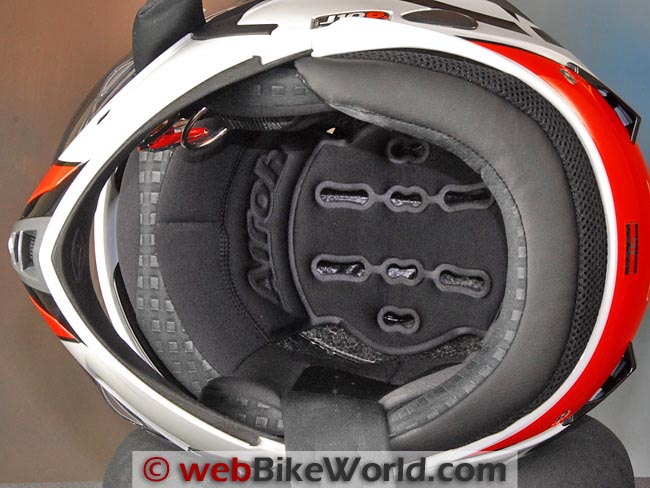
Airoh J106 Face Shield, Eye Port, Outward Visibility and Sun Visor
In its “Jet” configuration (J homologation) with the chin bar removed, the J106 feels comfortable and the shell sides flex enough to make a snug but comfortable fit on my head.
For me, it’s the preferred configuration because the installation of the chin bar definitely tightens up the sides of the helmet, greatly reducing the flex in the shell. The pointy chin bar also reduces the amount of room inside the helmet for me.
The face shield is a relatively thick 2.27 mm and it is ready for a Pinlock anti-fog insert (review), which is available as an accessory.
It rotates up or down in one position only; there are no multiple detents to choose from. It has a sort of “bubble” or “bug eye” look, where it meets the upward angle of the chin bar with a dramatic dip at the nose.
The lift tabs are located on either side of center on the face shield.
There is some distortion along the edge of the face shield at the indent or cutout for the nose, so if you look down the distortion will be visible.
But it’s otherwise a clear view that provides slightly better than average visibility in the horizontal and vertical planes when the chin bar is installed.
With the chin bar removed, of course, the visibility is outstanding because there’s nothing to block it below. And the face shield rotates down far enough to provide decent coverage to the face whilst riding.
A very soft silicone gasket seals the top and bottom of the face shield. There’s a small gap where the chin bar meets the helmet shell but this doesn’t seem to affect water entry.
The internal sun visor operates with a spring-loaded slider on the left hand side of the helmet, just below and behind the ear. The sun visor is either up or down; there are no intermediate positions.
It doesn’t rotate down far enough to remain out of the rider’s line of sight and it has a fairly radical curvature along the bottom and a cutout for the nose that are also in view.
The face shield removal system on the J106 is basic but workable. A plastic disk can be unscrewed about a half-turn after the face shield is raised. The disk comes off and the face shield can be removed.
To replace it, press it on the boss and push in the disk, turn it and it clicks and locks, more or less feeling like you’re turning a key in a door.
Overall, the visibility, face shield and its operation on the good but…different.

Score: The Airoh J106 visibility is slightly better than average in the P configuration and excellent in the J (Jet) configuration.
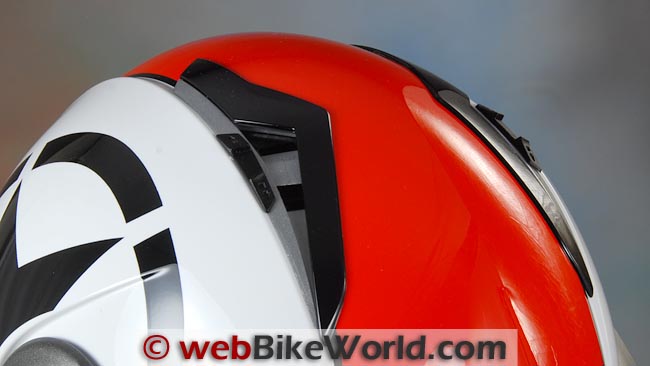
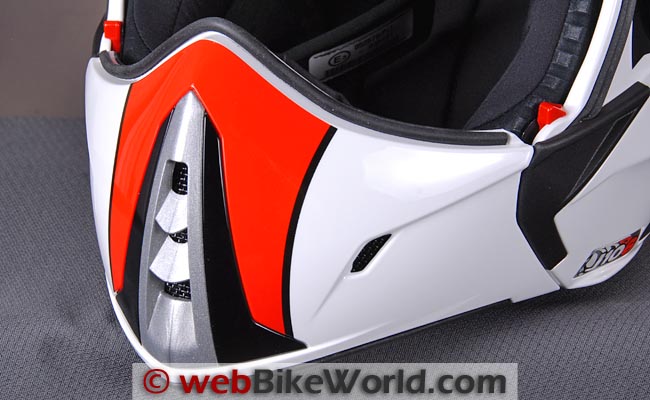
Airoh J106 Ventilation and Air Flow
The removable chin bar installed on the Airoh J106 has several flow-through vent channels but there is no switch or lever to close the vents if desired. So with the chin bar installed, the air always flows in and can not be stopped.
This is probably a good thing, considering the close fit of the chin bar to the rider’s mouth…
Of course, with the chin bar removed, ventilation is outstanding, with lots of air flowing up from underneath the face shield, as it does on any open-face helmet.
The top vents are located farther back than normal, with slots located in the center at the top of the helmet. They each have a slider to open or close the vent in two positions.
The slots flow air down on to the rider’s head through large vent channels through the EPS and the upper part of the helmet liner.
The top vents work well, albeit at the expense of some noise. But overall, the ventilation system on the J106 is rated as better than average, with the caveat that you’ll get a lot of air whether you want it or not.
The combination of lightweight thermoplastic shell, thin padding and ventilation, along with the convertible ability to morph the helmet from full-face to open-face style, make the J106 a probable choice for riders in warm climates.

Score: The Airoh J106 gets an “Excellent” rating for ventilation.
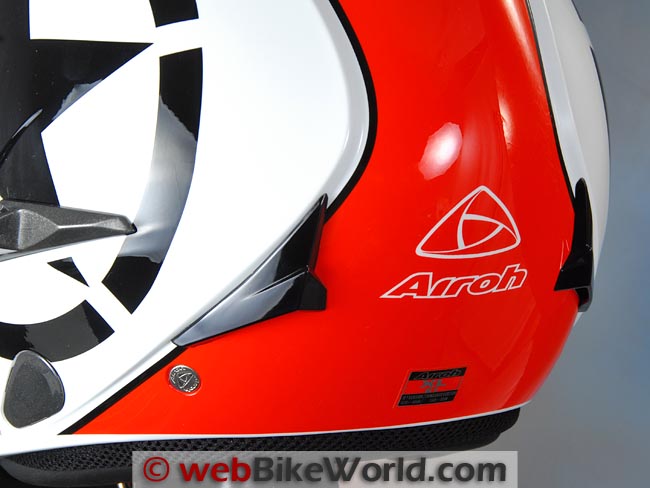
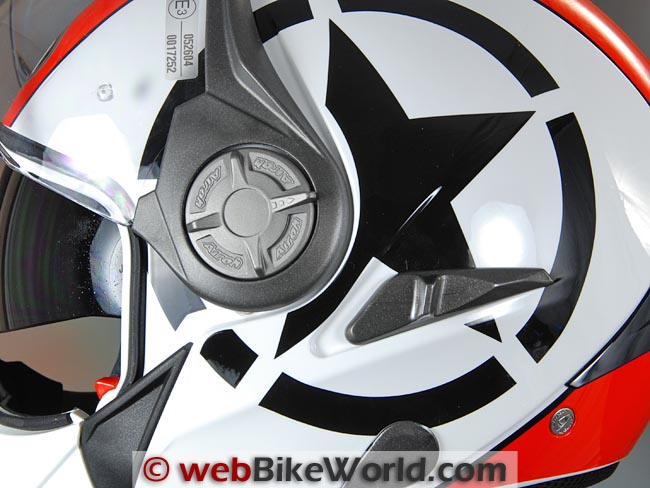
Airoh J106 Sound Levels
Like its grandfather, the Airoh TR-1, the J106 is quieter than expected, what with the thin thermoplastic shell and thin padding.
But somehow, it works; probably a combination of good aerodynamics and tight fit.
There is some noise from the top vents that gets louder when riding a motorcycle with a windscreen that directs its air turbulence at the top of the helmet. But overall, I’d say the noise levels are average to slightly quieter than average.
I have a feeling this may vary dramatically, depending on the way the helmet fits an individual rider and the motorcycle type, but I can relay only my experiences.
There is also some wind noise from underneath the face shield when the J106 is being used in the open-face or “Jet” configuration, but it seems normal for this type of helmet.



Note that our helmet evaluations are a combined effort of several riders over time on different types of motorcycles with and without windscreens.
Evaluators wear correctly fitted, high quality ear plugs (even when evaluating motorcycle intercom systems).
Always protect your hearing when riding a motorcycle. See the wBW Earplug Reviews for more information on choosing and wearing earplugs.
Note also that perceived noise levels will vary, depending on the individual.
Noise can be caused by many factors, including helmet fit, the type of motorcycle and windscreen, wind speed and direction and even the rider’s clothing.
For more information on helmet noise, visit the wBW Motorcycle Helmet Noise page.
Score: We’ll give the Airoh J106 a “Very Good” rating for noise control.
Airoh J106 Helmet Weight
Here’s where the Airoh J106 really shines It’s a flyweight, with this one passing the scales at only 1387 grams in size XL (3 lbs., 0.875 oz.).
That makes it one of the top 5 lightest helmets ever reviewed on webBikeWorld.com — and there are over 190 helmets in that group as of this writing.
The thermoplastic shell and minimalist construction comes into play here, dramatically reducing the overall mass, which makes a real difference when riding.
It feels more like a bicycle helmet than any other full-face (or open-face, for that matter) helmet you can wear.
For the record, the only helmets actually weighed by webBikeWorld that are lighter than the J106 are the carbon-fiber race helmet, the Akuma Phantom II MFR (review) at 1367 grams and the Nexx XR1R (review) in size large at 1382 grams
Also the Nexx XR1R Carbon (review) in size large, which we weighed at 1219 grams (newer versions weigh considerably more).
Note that all of the helmets reviewed on webBikeWorld have been weighed on a calibrated scale and the weights are available on the wBW Motorcycle Helmet Weights page.
Also see the chart that lists the helmets by weight and shape on the wBW Motorcycle Helmet Shapes page.
Score: We rate the Airoh J106 as “Outstanding” for its low weight and good balance.



Airoh J106 Modular Conversion
Converting the J106 from “P” (Protective, or full-face) to “J” (Jet, or open-face) configurations couldn’t be easier.
Push down on the two red buttons on top of the chin bar (one on either side) and simply pull the chin bar away from the helmet. That’s all there is to it.
Replacing it is just as easy — it snaps back in. It may take a try or two to get the hang of replacing the chin bar when you’re wearing the helmet.
I found that looking in a mirror for a bit of practice helps develop the “muscle memory” to know where to hold the tabs to slide them into the helmet shell.
The only trick is storing the chin bar once it has been removed. Don’t lose it!
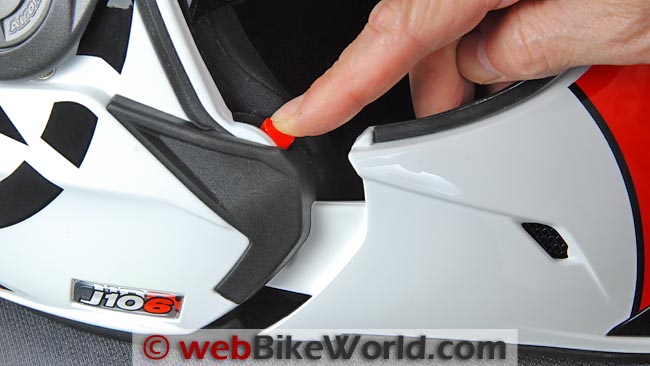


Miscellaneous
The J106 has a stylized and lightweight, specially designed Airoh “Microlock” chin strap retainer, which works well. Two large sections of padded strap work very well to protect the rider’s neck.
The Airoh J106 meets the ECE 22.05 P (Protective, or full-face) and J (Jet, or open-face) helmet safety standards for use while riding a motorcycle.
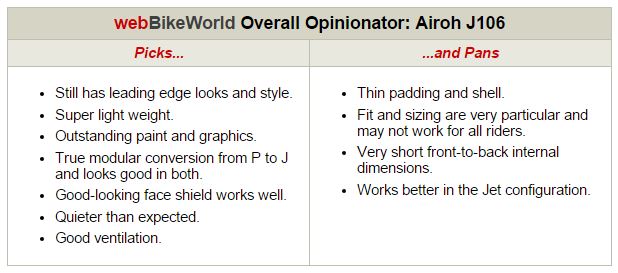


Conclusion
The Airoh J106 is a direct descendent of the Airoh TR-1 and it improves on that design with upgraded components and more style.
The J106 has a different type of fit and feel than other helmets, so it may not work for as many riders. But if it fits, you’d be hard-pressed to find a cooler-looking helmet anywhere on the planet, there’s no doubt about that.
It is also extremely light weight, which results in a liberating feel when riding, especially when using the J106 in its “Jet” or open-face configuration.
In fact, I’d consider it as more of an open-face design that has the option of adding the chin bar if desired. The helmet fits more comfortably when worn that way and it looks good too.
| wBW Review: Airoh J106 Helmet | |
|---|---|
| Manufacturer: Airoh (Italy). | List Price: €199 to €250 |
| Colors: Solids, graphics and replicas. | Made In: Italy |
| Sizes: XS-XL Shell Sizes: One | Review Date: June 2012 |
Owner Comments and Feedback
See details on submitting comments.
From “J.C.” (May 2014): “I also love my J-106. I totally agree with your comments about it being rather short front to back – my chin does touch the front when riding with the chin piece attached.
However, I do have a couple of issues with mine that almost ruin the experience for me. Firstly, the chin bar is much wider than the helmet. It doesn’t easily slide into the slots in the helmet.
After inserting one side into the slot, the other side is almost a whole inch out. I need to really compress it to get it narrow enough to fit. It’s as though the chin bar was made for a much larger helmet.
I was hoping for something that would be easy to install while out on a ride, but this is not the case.
Secondly, and much more serious for me, is that this is by far the noisiest helmet I have ever owned. Contrary to your findings my J-106 has a severe wind howl at any speeds above 30 mph.
I’m not a stranger to component or convertible helmets, having owned several, but this is something else.
I really think that without earplugs I would suffer permanent hearing damage almost immediately. It’s so bad I wonder if mine has been made badly or has some inner parts missing.
I’ve fitted a Scala Q3 intercom to mine and use it with some decent quality earbuds, but with my previous helmets they were optional, when riding alone I could leave them off and still be comfortable.
With the J-106 I can’t ride without them which is a shame.
Otherwise, I love it. It’s super light weight, great visors (both the sun visor and outer visor work perfectly and have resisted scratching completely, which I’m very pleased about) and fantastic looks mean I won’t be without it now.
It also has great ventilation when fully closed, with a thin blade of air being directed up around the outer visor at speed. Now if they could only fix the noise…”
Editor’s Reply: Note that webBikeWorld reviewers always wear high-quality, correctly fitted ear plugs when evaluating helmets and intercom systems and the noise evaluations reflect that practice.
From “J.F.C.” (January 2013): “I have the Airoh J-106 and absolutely love it…the open design and convertible options make it the best helmet I’ve used for peripheral vision, lightness and comfort.
Plus the sleek design reduces the whiplash effect when checking blind spots…I love this helmet.
I am however looking for a Bluetooth package and have yet to find one stateside that is compatible — any suggestions from you or your readers?”
Editor’s Reply: Any system that can be clamped or installed behind the removable chin bar should work?


